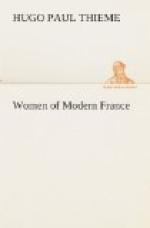In the beginning of the century, D’Urfe’s novels were in vogue; these works were characterized by interminable developments, relieved by an infinite number of historical episodes. All characters, shepherds as well as noblemen, expressed the same sentiments and in the same language. There was no pretension to truth in the portraying of manners and customs.—A reaction was natural and took the form of either a kind of parody or gross realism. These novels, of which Francion and Berger Extravagant were the best known, depicted shepherds of the Merovingian times, heroes of Persia and Rome, or procurers, scamps, and scoundrels; but no descriptions of the manners of decent people (honnetes gens) were to be found.
The novels of Mlle. de Scudery, while interesting as portraitures, are not thoroughly reliable in their representation of the sentiments and environment of the times; on the other hand, those of Mme. de La Fayette are impersonal—no one of the characters is recognizable; yet their atmosphere is that of the court of Louis XIV., and the language, never so correct as to be unnatural, is that used at the time. Her novels reflect perfectly the society of the court and the manner of life there. “Thus,” says M. d’Haussonville, “she was the first to produce a novel of observation and sentiment, the first to paint elegant manners as they really were.”
Her first production was La Princesse de Montpensier (1662); in 1670, appeared Zayde, it was ostensibly the work of Segrais, her teacher and a writer much in vogue at the time; in 1678, La Princesse de Cleves, her masterpiece, stirred up one of the first real quarrels of literary criticism. For a long time after the appearance of that book, society was divided into two classes—the pros and the cons. It was the most popular work of the period.
M. d’Haussonville says it is the first French novel which is an illustration of woman’s ability to analyze the most subtile of human emotions. Mme. de La Fayette was, also, the first to elevate, in literature, the character of the husband who, until then, was a nonentity or a booby; she makes of him a hero—sympathetic, noble, and dignified.




